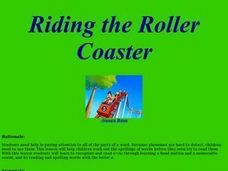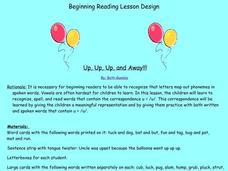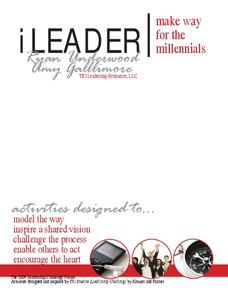Curated OER
The Not-So-Scary Creaky Door!
Students recognize the short vowel e in spoken language. Through listening activities, they discriminate the short vowel phoneme /e/ from other phonemes. Students associate the phoneme with its letter representation and identify the...
Curated OER
Icky, Icky, Sticky!
Students recognize the short vowel I in written and spoken language. Through matching activities, they discriminate the short vowel /i/ from other vowel sounds. Students associate the phoneme with its letter representation and identify...
Curated OER
Eek, It's a Spider
Students recognize the short vowel e in written and spoken language. Through listening and matching activities, they discriminate the vowel sound /e/ from other phonemes. Students identify the phoneme and letter in words while reading a...
Curated OER
Iiicky, Stiicky, I
First graders recognize the short vowel i in written and spoken language. Through listening and matching activities, they discriminate the vowel sound /i/ from other phonemes. Students identify the phoneme and letter in psuedo words they...
Curated OER
Riding the Roller Coaster
First graders recognize the short vowel a in written and spoken language. Through matching and listening activities, they discriminate the vowel sound /a/ from other phonemes. Students associate the phoneme with its letter representation...
Curated OER
Bubbly Bs and Dull Ds
Students practice discerning between the letters D and B. Through hands on activities, they recognize the difference between the commonly confused letters B and D. They practice writing both letters and correcting common mistakes and...
Curated OER
Abigail Ant
Pupils recognize the short vowel a in written and spoken language. Through matching and listening activities, they discriminate the vowel sound /a/ from other phonemes. Students identify the phoneme and letter in words and pictures.
Curated OER
Open Wide and Say Ahh
Pupils recognize the short vowel o in written and spoken language. Through matching and listening activities, they discriminate the vowel sound /o/ from other phonemes. Students identify the phoneme and letter in words and pictures.
Curated OER
Up, Up and Away
Students recognize the short vowel u in written and spoken language. Through matching and listening activities, they discriminate the vowel sound /u/ from other phonemes. Students identify the phoneme and letter in words and pictures.
Curated OER
Cracking Sticks
Students explore the letter /k/ in this lesson, and identify the /k/ sound in words. They read a tongue twister emphasizing the /k/ sound, and discuss that two letters make the /k/ sound - c and k. They then practice writing k's and...
Curated OER
Adam's Apples
Students recognize the short vowel "A" in written and spoken language. Through matching and listening activities, they discriminate the short vowel /a/ from other vowel phonemes. Students associate the phoneme with its letter...
Curated OER
Open Up and Say /o/
Students recognize the short vowel o in written and spoken language. Through matching and listening activities, they discriminate the vowel sound /o/ from other phonemes. Students identify the phoneme and letter in words and pictures.
Curated OER
It's Icky Sticky
Young scholars recognize the short vowel a in written and spoken language. Through matching and listening activities, they discriminate the vowel sound /a/ from other phonemes. Students identify the phoneme and letter in pseudo words...
Curated OER
We Want W!
First graders recognize the phoneme /w/. Through listening and matching activities, 1st graders discriminate the phoneme /w/ from other letters and phonemes. They associate /w/ with its letter representation and identify the phoneme in...
Curated OER
Coloring Phonics and Handwriting Hh
In this letter Hh worksheet, 1st graders fill in the 'h' in hot dog and then color the hot dog. Students trace the word hit dog and then the sentence 'It's a hot dog.'
Kelly's Kindergarten
April Daily Resources
Spring has sprung in your classroom! An entire month of activities relating to spring prompts learners to color, draw, write, and work on phonics.
Florida Center for Reading Research
Phonological Awareness: Phoneme Segmenting and Blending, Picture Slide
A hands-on activity challenges young scholars to name a picture, segment its phonemes, then blend those sounds to make the word.
Perkins School for the Blind
Initial Consonant Activity
Bingo is a super fun game and can be used to reinforce a vast number of recognition skills. These bingo cards are prepared by constructing nine squares, each delineated with raised Wikki Stix or gluedyarn and containing a braille...
K12 Reader
St. Patrick’s Day Words
A St. Patrick's Day-themed activity invites young leprechauns to match the word with its meaning by writing the corresponding letter in the blank. There are 10 words and definitions that are connected to Ireland. Lastly, pupils are...
Meadows Center for Preventing Educational Risk, University of Texas at Austin
Lesson 8 - Open Syllables
Just like scholars plug something in to close a circuit, they must plug a consonant onto a word to make closed syllables. Help learners distinguish between open and closed syllables with a series of activities that emphasize open...
Curated OER
Location on a Grid
Make coordinate pairs more engaging by having beginners color-code a grid based on given locations. The grid has numbers along the y-axis and letters along the x-axis, introducing them to the ordering of coordinate pairs with the x-axis...
Curriculum Corner
Ice Cream Booklet
On the days leading up to summer, use a booklet of practice skill sheets in the classroom. Beginner pupils should be able to master the skills they've learned in math and reading before they head home for the summer, like counting to 30,...
Leadership Challenge
Rock the Clock
Watch young leaders as they totally rock this activity! Pupils partner up and set appointments with one another during the third in a series of 12 character-building lessons. Instructors call out the appointment time, then partners meet...
Curated OER
Missing Numbers to Twenty
Which number is missing? Beginning counters examine twenty-six number sequences, one for each letter of the alphabet. Each sequence has four numbers, ranging from one to 20. There is one number missing from the sequence, and learners...

























